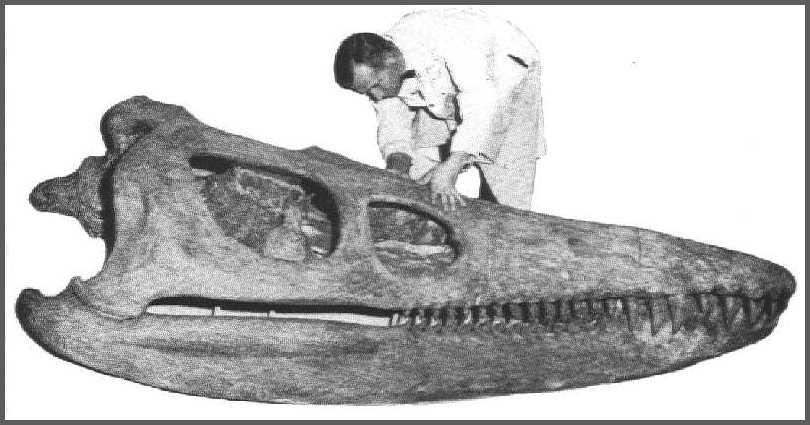
Classification
Domain:
Eukarya →
Kingdom: Animalia
Phylum: Chordata
→
Class: Sauropsida
Order: Plesiosauria
→
Family: Pliosauridae
Genus: Kronosaurus
→ Species:
Queenslandicus
When looking further into the classification of the
Kronosaurus, we noticed that there are several modern
day species that could in fact be relatives of this giant creature.

This picture shows a preparator (Arnie
Lewis) working on the 9 foot long (2.7 m) skull of Kronosaurus
queenslandicus at the Harvard Museum of Comparative Zoology.
Domain: Eukarya
This specific domain is one in which the organism's cells contain a
true nucleus.
Kingdom: Animalia
Organisms within Animalia are multicellular. They are also
heterotrophs, a term meaning that they rely either directly or
indirectly on other organisms as sources of nourishment.
The range of organisms within this kingdom is very broad. Organisms
such as the Domesticated Cat,
Alces
alces and even the
Asian Elephant can be classified within the kingdom.
Phylum: Chordata
Here we can see that all of these organisms have a series of
structures in common. They have a
notochord. This is a structure that is present in the
embryos. As the organisms mature, this structure can become
reduced or absent all together. Another shared structure
within this phylum is the pharyngeal slits. These slits were
originally used as a tool in the filter feeding process (Everhart,
2009). They would filter our particles of food and enable them
to stay in the animal's body to later be put into the digestive
tract. Within this phylum, one can see fish, amphibians,
reptiles, birds and mammals. Animals such as the
Cane Toad,
Albacore
tuna,
Crocodylus actus and
Colinus
virginianus, along with many others, can be seen within the
phylum.
Class: Sauropsida
This class is comprised of vertebrates. Sauropsida includes what was
classically known as "Reptilia" along with birds and dinosaurs.
Order: Plesiosauria
This is an extinct order of Mesozoic marine reptiles.
Family: Pliosauridae
This family existed from the Earliest Jurassic to the early Late
Cretaceouw.
Genus: Kronosaurus
This is an extinct genus of short neck pliosaurs.
Species: Queenslandicus
Kronosaurus qeenslandicus is from the Early Cretaceous of Queensland. This is the
largest known pliosaurid. Using it's pairs of limbs, this monstous
carnivore traveled the oceans and inland seas during the Mesozoic.